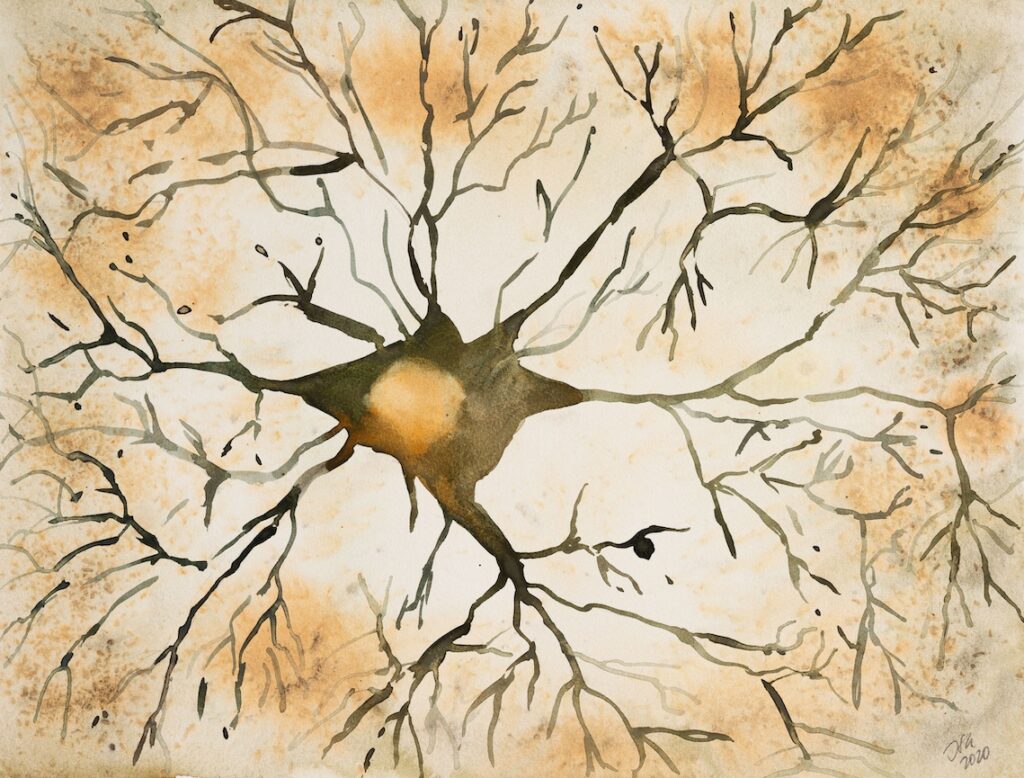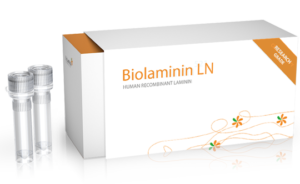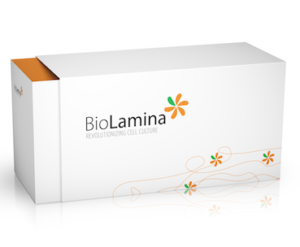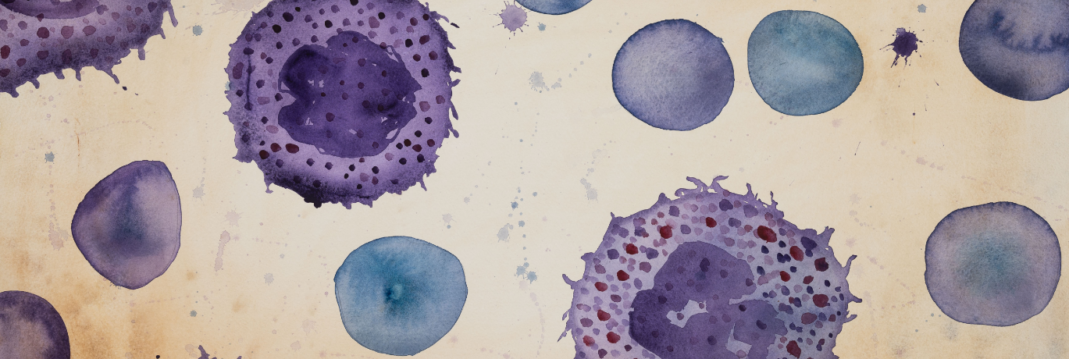Glial cells

Biorelevant culture of glial cells on Biolaminin substrates
Microglial cells – the resident macrophages/immune cells in the central nervous system
Inflammatory responses to CNS damage are mediated by microglia. Activation of microglia is a complex, multistage process making them capable of releasing a large number of substances that can act both detrimental or beneficial for the surrounding cells. Recent studies indicate though that even in the normal brain, microglia have highly motile processes reaching out to synapses, eliminating unwanted connections in a process called pruning.
Microglia are of myeloid nature and ontogenetically related to macrophages, but their origin is still debated. During early fetal development, microglia derive from primitive myeloid macrophages in the yolk sac, seed the brain and under steady-state conditions, they will maintain themselves until adulthood. However, in response to CNS damage, numbers of microglia increase, which can be explained by the recruitment of monocytes from the bone marrow, supplementing the resident microglial population.
Laminin is a crucial factor to drive microglia into an inflamed state
In a recent study, Pietrogrande and colleagues have addressed the potential role of the extracellular matrix protein laminin as a crucial factor to drive microglia into an inflamed state (Pietrogrande, 2017). Chronic restraint stress of C57BL6 adult mice resulted in elevated levels of laminin-α1 and pro-inflammatory markers such as TNF-α and iNOS. Immunolabeling of laminin-α1 identified pyramidal neurons and dentate gyrus to be their primary source within the hippocampus. Furthermore, Iba-1 staining of microglia revealed that chronic stress also strongly reduced the total branch length, number of primary branches and number of branching points when compared to microglia of control mice. In vitro, primary microglia and BV2 cells grown on Biolaminin 111 expressed higher levels of TNF-α, IL-1β, and iNOS. In addition, LPS activation of microglia coated on Laminin-111 led to an increased pro-inflammatory state represented by higher pro-inflammatory cytokines level and phagocytic capability, both before and after stimulation. Interestingly, similar to observations made in vivo, microglia cultured on Biolaminin 111 had fewer ramifications compared to control. These results expose the capability of chronic restraint stress in modulating Laminin within the CNS, an effect that has implications for understanding environmental mediated disturbances of microglial function.
Laminins relevant to microglia
The main laminin isoforms synthesized by human bone marrow stromal cells are laminin 411/421 and laminin-511/521 (Siler, 2000). Microglia constitutively express a6b1 integrin (Milner and Campbell, 2002) and monocytes synthesize and migrate on laminin 411 and adhere to laminin 411 via a6b1 integrin (Pedraza, 2000). Laminin isoforms 511, 521 and 411 are adhesive proteins for precursors of myelomonocytic cell lineages (Gu, 2003).
Astrocytes
Astrocytes express laminin isoforms 111, 211 and 521 (Sixt, 2001; Jucker, 1996). Yao and colleagues (Yao, 2014) showed that laminin 111 and laminin 211 are essential for the maintenance of the blood-brain barrier integrity by regulating the differentiation of pericytes. It has also been shown that laminin 521 is indispensable for retinal angiogenesis and astrocyte migration (Gnanaguru, 2013).
hiPSC-derived astrocytes provide a promising source of astrocytes for screening models, but generally, the protocols are extensive and use undefined conditions, introducing variability. Lundin and colleagues (2018) reported a protocol for human induced pluripotent stem cell (hiPSC)-derived astroglia (NES-Astro) developed under defined conditions through long-term neuroepithelial-like stem (ltNES) cells. The authors showed high reproducibility across hiPSC lines, and proven astrocyte functions including SLC1A3-driven glutamate uptake, immune competence, and calcium responsiveness to neurotransmitters. With the use of human recombinant Biolaminin 521, their culture system is animal-free and applicable for good manufacturing practice and clinical adaptation.
Oligodendrocytes
Relucio and colleagues (2009) showed that α2-laminins (laminin 211 and laminin 221) are required for the maturation of oligodendrocytes. Moreover, and in support, lama2-mutant mice exhibit CNS myelination defects (congenital muscular dystrophy) due to impaired oligodendrocyte maturation (Chun, 2003).
Schwann cells
Schwann cells, responsible for the formation of myelin sheaths around nerve axons in the peripheral nervous system, require laminin isoforms 411 and 211 to spread and sort axons (Pellegatta, 2013). In addition, Petersen and colleagues (2015) demonstrate and provide evidence of the fundamental role of laminin 211 in Schwann cell biology as a regulator of radial sorting, driving the terminal differentiation and thus, myelination of axons.
Poitelon and colleagues (2016) also showed that laminin 211 in combination with mechanical stimuli activate Yap and Taz, downstream effectors in the Hippo pathway, required for radial sorting and myelination. Apart from promotion, laminin 211 can also inhibit myelination by modulating neuregulin 1 type III activity via PKA signaling and thereby prevent inappropriate and excessive myelin wrapping of small nerve fibers (Ghidinelli, 2017).
Succeed with your application
-
Direct Reprogramming of Human Fetal- and Stem Cell-Derived Glial Progenitor Cells into Midbrain Dopaminergic Neurons
Nolbrant S., Giacomoni J., Hoban D.B, Bruzelius A., Birtele M., Chandler-Militello D., Pereira M., Rylander Ottosson D., Goldman S.A., Parmar M. Stem Cell Reports, 2020
Read more -
Instructions 001: Coating with Biolaminin substrates
Protocol and concentration calculations for coating cultureware with Biolaminin
Open pdf -
Instructions 011: Biosilk 3D scaffolds for differentiation and proliferation of hPSCs
Protocol for human pluripotent stem cell expansion, differentiation and organoid formation in 3D
Open pdf -
Human iPS-Derived Astroglia from a Stable Neural Precursor State Show Improved Functionality Compared with Conventional Astrocytic Models
Anders Lundin, Louise Delsing, Maryam Clausen, Piero Ricchiuto, José Sanchez, Alan Sabirsh, Mei Ding, Jane Synnergren, Henrik Zetterberg, Gabriella Brolén, Ryan Hicks, Anna Herland, and Anna Falk Stem Cell Reports, 2018
Read more
Biolaminin Key Advantages
Laminin isoforms 111, 211, 411, and 521 have fundamental roles in the biology of astrocytes, oligodendrocyte and Schwann cells. Microglia constitutively express a6b1 integrin – a common receptor of laminin 521. Biolaminin 521 has been used in protocols for differentiation of human induced pluripotent stem cell-derived astroglia through long-term neuroepithelial-like stem cells.
Specific laminin isoforms are present in different tissue microenvironments and are essential for cell survival, proliferation, and differentiation. Biolaminin products allow you to imitate the natural cell-matrix interactions in vitro.
All our matrices are chemically defined and animal origin-free, which makes them ideal substrates for each level of the scientific process – from basic research to clinical applications.
Our products have consistent composition and quality. This enables minimized variability between experiments.
Numerous scientists have found our products and finally succeeded in their specific stem cell application. The power of full-length laminins incorporated into various cell systems is well documented in scientific articles and clinical trials.
Recommended products
-

Biolaminin 111 LN (LN111)
Full-length human recombinant laminin-111
Biolaminin 111 is a full-length laminin-111 protein—an essential extracellular matrix component for many cell types in vivo. It has proven particularly effective in supporting the differentiation of functional hepatic and neural cells in a chemically defined and xeno-free culture.View product -

Biolaminin 211 LN (LN211)
Full-length human recombinant laminin-211
Biolaminin 211 supports the growth, survival, and differentiation of a wide range of tissue-specific cell types, including motor neurons, cardiac cells, and skeletal muscle cells.View product -

Biolaminin 511 LN (LN511)
Full-length human recombinant laminin-511
Biolaminin 511 is the natural laminin for mouse embryonic stem cells, supporting sustained pluripotency without the need for LIF. It also efficiently promotes the culture of many tissue-specific human cell types.View product -

Biolaminin 521 LN (LN521)
Full-length human recombinant laminin-521
Biolaminin 521 LN is a full-length laminin-521 substrate—the natural laminin for pluripotent stem cells, reliably facilitating ESC and iPSC self-renewal in a chemically defined, xeno-free stem cell culture system. It also uniquely promotes the growth and identity of various tissue-specific human cell types.View product -

Biolaminin 411 LN (LN411)
Full-length human recombinant laminin-411
Biolaminin 411 supports diverse tissue cell types such as cells from the pancreas and the vascular, immune, nervous, and hematopoietic systems.View product -

Biolaminin 121 LN (LN121)
Full-length human recombinant laminin-121
Biolaminin 121 is a full-length human laminin-121 protein that can be used as a general attachment protein for many cell types in vitro.View product -

Biosilk 521
3D culture substrate
Biosilk 521 is a natural biomaterial made of spider silk and laminin 521 – a biocompatible 3D culture mesh for expansion and long-term differentiation of human pluripotent stem cells and for organoid formation of various cell types.View product

Talk to our team for customized support
We are here to help you in your journey.